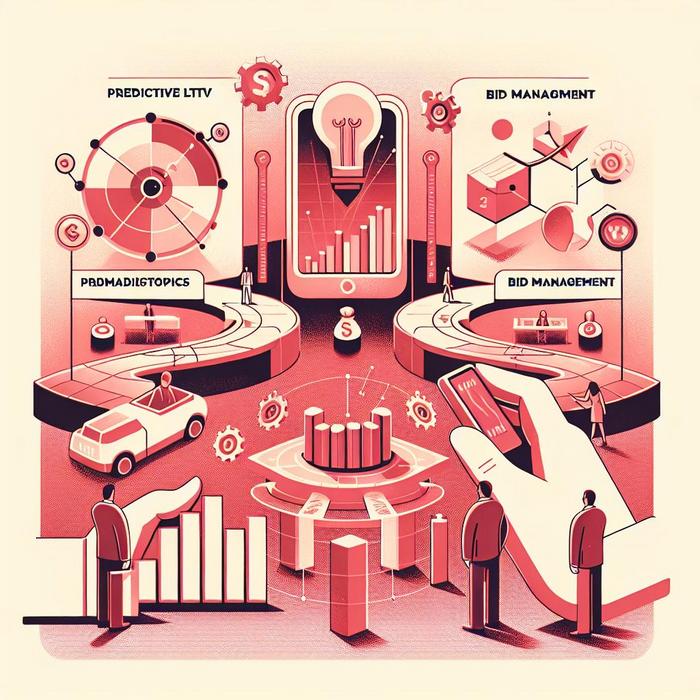Google Ad Strategies: Embracing Predictive LTV
As a seasoned digital marketer, I’ve witnessed first-hand how high-level executives continuously seek new avenues to fuel growth and improve their strategic decision-making process. From my experiences, one area of untapped potential lies in fully harnessing the potential of Predictive Lifetime Value (LTV) models in Google Ad Strategies, a factor that can redefine bid management.
Moving Towards Predictive LTV
The evolution of Google’s bidding strategies to include predictive LTV models is a significant leap forward. It’s a change that warrants exploration by any executive striving to understand and maximize their customers’ value.
In one of my experiences working with a leading FMCG client, I realized their customer retention was significantly lower than the industry average. After a deep-dive analysis, I found out that the problem wasn’t in the product quality or pricing, but in their advertising strategy which was overlooking customer lifetime value.
How Predictive LTV Models Can Refine Google Ad Strategies
Predictive LTV models step beyond traditional methods by incorporating each customer’s future potential into your advertising strategy. This forward-looking approach allows brands to strategically bid for Google ads, optimizing for those customers who are most likely to bring long-term value.
To illustrate how predictive LTV redefined the FMCG client’s Google ad strategy, here are the critical steps:
1. Understanding Each Customer’s Future Value: By analyzing historical transaction data, we could predict the future spend of individual customers.
2. Targeted Ad Spending: Using this data, we could invest our ad budget on attracting and retaining customers with the highest future spending potential.
3. Improved ROI: This data-driven approach helped the client enhance customer retention and improve return on ad spend by 20%.
Predictive LTV: Enabler Of Ad Campaign Resilience
A crucial aspect of a predictive LTV approach is its ability to fuel ad campaign resilience. This is particularly useful for businesses operating in volatile markets where real-time data can significantly impact decision-making.
For instance, our FMCG client operated in a highly competitive environment with frequent price changes. The predictive LTV models adapted to this volatility, adjusting the bid management strategy in real-time. This ensured our client’s Google ad strategy remained competitive, despite market fluctuations.
Scaling Globally using Predictive LTV
Another area where Predictive LTV shines is in scaling global campaigns. When a luxury retailer wanted to expand their global reach, we put predictive LTV to work to identify the most lucrative markets for them. By using predictive models, we were able to strategically invest their ad budget across Google’s global networks, securing a significant boost in their global customer base.
Influencing Ad Budget Allocations For Optimal ROI
As a CFO in today’s digital age, understanding how a predictive LTV approach can influence ad budget allocations is paramount. By understanding the future value of customers, CFOs can inform data-driven investment decisions for their ad budget allocations. Just as the predictive LTV approach informed our FMCG client’s ad spend strategy, it can also inform yours, leading to an optimal return on ad spend.
Looking ahead, it is clear that the future of Google Ad Strategies lies in the hands of predictive LTV models. The potential to unlock long-term customer value and optimize bid management makes this an essential tool for high-level executives. Like myself, I believe you’ll find the journey intriguing and transformative to your digital marketing strategy.
When Predictive LTV Models Meet Advanced Analytics
During my time heading a multinational consumer tech company’s digital marketing campaign, integrating predictive LTV models with advanced analytics provided a powerful combination for bid management optimization. Predictive LTV, when paired with the latest Google Ads analysis tools, presents a clear line of sight for executives to make crucial data-backed decisions that serve to maximize customer lifetime value.
1. Customer Segmentation: Advanced analytics enabled us to dive deeper into our customer data and segment them based on their predicted future value.
2. Strategic Resource Allocation: Informed by these insights, we devised a strategy that allowed efficient allocation of resources towards the targeted high-LTV customer segments.
3. Impact: The systematic data-driven funnel contributed to a 40% increase in customer retention and a surge in overall profit margins.
Google Ads and The Power of Predictive LTV
To illustrate the transformative potential of this approach, I refer to a case when I was consulting a major e-commerce platform. They approached at a time when they wanted to upscale their operations and improve profitability. To achieve their objectives, we overhauled their Google Ads strategies and incorporated predictive LTV models.
By analyzing past purchasing behaviours and patterns, we were able to ascertain customers’ future potential, gaining valuable insights to strategize our bid management. This shift in the advertising approach not only improved the customer acquisition process but also steered the focus towards maintaining high-value customers and improving their repeat purchasing rate. The upshot of these systematic and strategic changes was a quantum leap in return on ad spend, along with a sharp hike in customer lifetime value.
Preparing For The Unexpected: LTV for Bidding Optimization
Another noteworthy event that sprung from my journey to infuse more value into online advertising was during an unforeseen turbulent period for a client in the hospitality industry. When unpredictable market changes threatened the efficiency of their online advertising campaigns, we turned to predictive LTV for bidding optimization. This approach allowed us to swiftly adapt our bidding strategies to changing market requirements, ensuring seamless campaign execution even amidst chaos, and, consequently, preserving a high rate of customer retention.
Decoding the Potential with Smart Bidding Practices
While working on a project for a large-scale Fintech firm, the concept of predictive LTV gained a new dimension when merged with Google’s Smart Bidding. This smart combination provided an added layer of intelligence and sophistication to their ad bidding strategy, leading to more efficient management of the ad budget and higher returns.
1. Precision Bid Management: By leveraging machine learning, Google’s Smart Bidding algorithm precisely adjusted the Fintech firm’s bid amounts, factoring in the potential future value of each customer.
2. Driven by Results: This data-driven approach successfully reduced the cost per acquisition, resulted in a higher number of clicks per dollar of ad spending, and paved the way for a more successful ROI.
Looking Ahead…
It’s certain that advancements in predictive LTV and machine learning are injecting a new level of sophistication into Google Ad Strategies. A testament to this is the vast growth and profitability that organizations, big or small, are experiencing by capitalizing on this untapped potential in their advertising strategy. It’s a shift that resonates well with seasoned executives and delivers a forward-looking approach to drive growth and profitability.
As we navigate this digital era, offering increased opportunities for businesses to tap into unexplored value segments, it’s crucial to progressively embed the practice of predictive LTV in your Google Ad strategy. And as you do, I have every piece of confidence that the results will exceed your expectations, just as they have for my clients and me.









